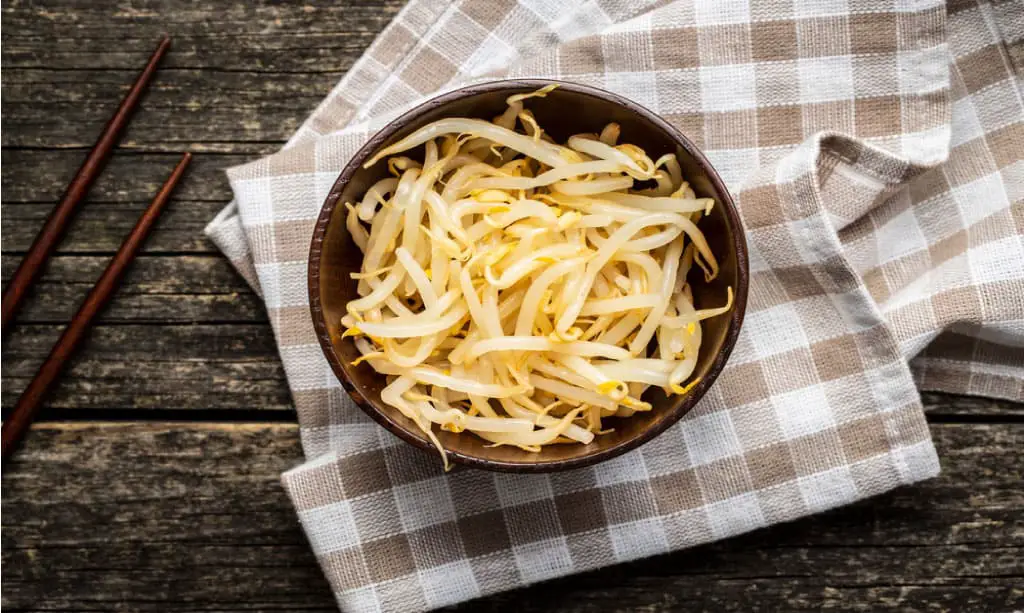If you’ve ever wandered through a grocery store, aisle after aisle, and searched for the bean sprouts you need for your Pad Thai dish, only to go home empty-handed, you’re not alone. Finding sprouts in a grocery store, especially fresh bean sprouts, can seem to be an impossible task, and that’s because sometimes it is!
Most large grocery stores may carry canned bean sprouts in the ethnic foods or canned bean and vegetable section, but many no longer sell fresh bean sprouts due to the high risk of carrying foodborne illnesses.
Bean sprouts are one of the foods that most often carry foodborne illnesses, even more so than raw fish or other produce. It has to do with the conditions required for their growth. Read on to learn more and discover what types of grocery stores actually carry fresh bean sprouts.
Finding Canned Bean Sprouts in a Grocery Store
If you are at the grocery store and have everything else in your cart that you need for your culinary adventures, but are just missing the bean sprouts, check with the canned foods!
Many people find that if they plan to cook their sprouts into their meal rather than eat them fresh, canned sprouts will do the trick. Canned sprouts are not only much easier to find, but they are also easier to store and prepare. They can be tossed into stir-fry’s, Pad Thai’s, wraps, and other delicious meals and give you the crunch and the health benefit without all the hassle.
Canned bean sprouts can typically be found in the ethnic foods section of a grocery store. This section can carry products and foods from many different cultures, including:
- Chinese
- Indian
- Thai
- Mexican
- Italian
- Korean
- Japanese
That is not even an all-inclusive list; there may be foods with influences from other countries. Each grocery store will differ in what kinds of ethnic foods they carry based on the location, availability, and demand of the area. Often, though, canned bean sprouts can be found in these sections with other foods that are Asian inspired.
If your local grocer does not have an ethnic foods section or canned bean sprouts to be found in that section, they can occasionally be found with the other canned beans or vegetables. Frequently these items will have their own aisle or section, and you may be able to find them there.
While the canned bean sprouts may bring a different set of flavors and textures to a dish instead of the fresh bean sprouts, they can be a good alternative if you can’t find the fresh ones or are wishing to avoid any risk of foodborne illness.
Finding Fresh Bean Sprouts
Although many larger chain grocery stores don’t carry them, they can be found in other stores.
Smaller local grocery stores may carry them. Additionally, organic grocers and Asian markets of any kind are a safe bet for finding fresh sprouts of all kinds.
Calling ahead to ask the customer service representatives if their store carries fresh bean sprouts can save you a trip in vain.
If your local stores don’t carry them, letting the management know that you would be interested in purchasing them if they ever decided to carry them can go a long way towards making it happen.
Why Are Fresh Bean Sprouts Hard to Find?
In the last several years, there has been an increase in large-chain grocery stores that are unwilling to sell fresh bean, grain, or microgreen sprouts. Bean sprouts can come from a variety of beans, including:
- Soybeans
- Mung beans
- Lentils
- Garbanzo beans
- Black beans
- Kidney beans
- Green peas
- Snow peas
They can also come from different kinds of seeds and microgreens, including:
- Alfalfa seeds
- Radish
- Clover
- Fenugreek
- Pumpkin seeds
- Mustard greens
As well as some grains, such as:
- Oats
- Buckwheat
- Wheat
- Quinoa
- Brown rice
With all the different kinds of sprouts, there are so many options for different flavors, textures, and nutrients. There are also more opportunities, though, for bacteria growth and contamination.
The reason that Bean Sprouts pose such a serious risk for foodborne illnesses has to do with the way that they are grown. The environment required for optimum sprouting just so happens to be the optimum environment for bacteria growth, such as Salmonella, E. Coli, and Listeria. That environment must be very warm and very moist.
As different seeds, beans, and grains sprout, there are a few different opportunities for bacteria to contaminate it. If it is later on in the sprouting process that it becomes contaminated, then it can be treated with chlorine rinses, hot water, and/or steaming temperatures for cooking.
Suppose the sprouts were contaminated with the bacteria early on in their sprouting process. In that case, it is likely that the bacteria are growing within the seed or bean itself, and thus much more difficult to remove.
Another reason that many grocers choose not to carry sprouts is that their shelf life is so short. A fresh bundle of bean sprouts can be on the shelf looking vibrant and delicious, and within hours the sprouts begin to wilt, become slimy and discolored, or even produce an unpleasant smell. Therefore, it is often not worth it for grocers to carry them because they don’t get sold quickly enough to prevent waste.
Either way, the risk of foodborne illness and the short shelf life is enough to keep these fresh sprouts out of major grocery chains the majority of the time. If you can find some, consider it your lucky day and proceed with caution while you enjoy their flavor and nutrition.
Are Bean Sprouts Worth the Risk?
With such a high chance of contracting a foodborne illness from eating fresh bean sprouts, it can feel like too much of a risk sometimes. Understanding the health benefits of consuming fresh bean sprouts can help you make an educated decision about whether or not that risk is worth it to you.
Are You High-Risk?
First off, consider whether or not you are in a particularly high-risk category or not. Pregnant women are advised not to eat raw sprouts for the duration of their gestation to avoid life-threatening complications for themselves or their growing baby that can arise from foodborne illnesses.
The same is true for young children, the elderly, and anyone with other conditions that limit immune capability, such as cancer. The risk of complications arising from foodborne illness is significantly higher for these individuals, and it is often better to abstain entirely from consuming raw sprouts of any kind.
If you find that you are not in one of these high-risk categories, then let’s take a look at the benefits you might enjoy if you choose to consume raw bean sprouts.
Bean Sprout Benefits
All sprouts are considered low in calories and very high in nutrients, making them fall under the category of a “nutrient-dense” food. That means they give you more bang for your buck in terms of your health.
It has a lot to do with the actual sprouting process. According to Healthline.com, sprouting beans or other grains and seeds can actually increase their protein content and cause them to have more:
- Manganese
- Vitamin K
- Magnesium
- Folate
- Vitamin C
- Phosphorus
Perhaps even more than that, they are a great source of antioxidants and amino acids, which are fantastic for your health.
So, if you aren’t in a high-risk category, consider adding raw sprouts into your diet. Just be sure to follow guidelines about lessening or eliminating the risk for foodborne illness. These include:
- Store at a low temperature of 40 degrees Fahrenheit or below, in water.
- Wash thoroughly with running water.
- Wash your hands before preparing or handling them.
- Buy the sprouts that look fresh and free of any unappealing smells, sliminess, wilting, or discoloration.
Keep It Fresh
Although your larger grocery chains may not carry fresh bean sprouts, check the canned or ethnic section for canned bean sprouts. Fresh sprouts can often be found at specialized health food stores and organic, farmers, or Asian markets. As long as you have clarified that you are not a high-risk individual, be sure to follow food safety guidelines before enjoying this nutrient-dense food.
Sources: Thrivecuisine.com, nhs.uk, cdc.gov, eatright.org

